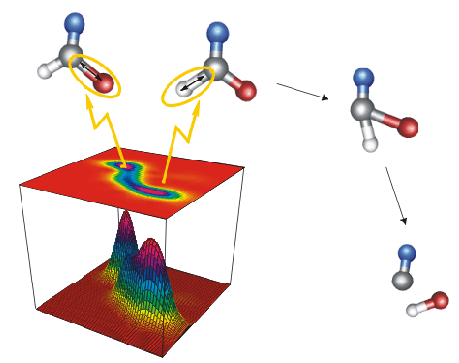
Often light-induced chemical reactions like isomerization, fragmentation, and electrocyclic reactions are completed within just a few femtoseconds (1 fs=10-15 seconds). Processes like these take place in many rapid biochemical and biophysical reactions and their dynamics are clearly dominated by the coherent wave character of the system because of the short timescales.
A prominent biochemical example is rhodopsin, the light-sensitive receptor protein enabling the vision process.
Prominent biophysical examples are the DNA nucleobases shielding the genetic code from radiation damage.
Owing to the development of short tunable laser pulses, these fast reactions have become experimentally observable (leading e. g. to the 1999 Nobel Prize in Chemistry for A. Zewail).
-
Coordinate Reduction
To understand the underlying mechanisms not only experiments with excellent time resolution (below 20 fs) but also theoretical research is necessary.
Our approach to describe wave phenomena in complex systems focuses on those molecular motions that are active on the femtosecond timescale only, thus reducing the numerical problem to a low-dimensional subspace of few reactive modes.
-
Conical Intersections
Characteristic for a large class of ultrafast reactions that we are interested in is the appearance of conical intersections.
These are conically shaped reaction channels that promote ultrafast transitions between different electronic states and are simultaneously branching points for different products.
-
Optimal Control Theory
Beyond observation, our goal is to control the outcome of chemical reactions by sophisticated modulated femtosecond light pulses.
The basic principle is that any quantum process can be influenced by constructive and destructive interference.
We have already demonstrated successful strategies for efficient laser control of chemical reactions such as photoswitching, vibrational ladder climbing and molecular quantum gates.
-
Methods
Our methods reach from quantum chemical computations of electronic structure to quantum dynamical propagation of wave packets or density matrices, including environmental influences in multiscale QM/MM schemes.
Apart from our own compute cluster, these simulations are performed on massively parallelized supercomputers such as the SuperMUC-NG in Garching, since they need considerable computational power.


